
PMS 134
Hex: #FFD16e
R: 255
G: 209
B: 110
C: 0%
M: 18%
Y: 66%
K: 0%
Customizing and Creating Resources
Before creating your own resources, please review our Talking is Teaching Graphic Style Guide. This guide contains useful tips as well as design rules for working with the Talking is Teaching brand.
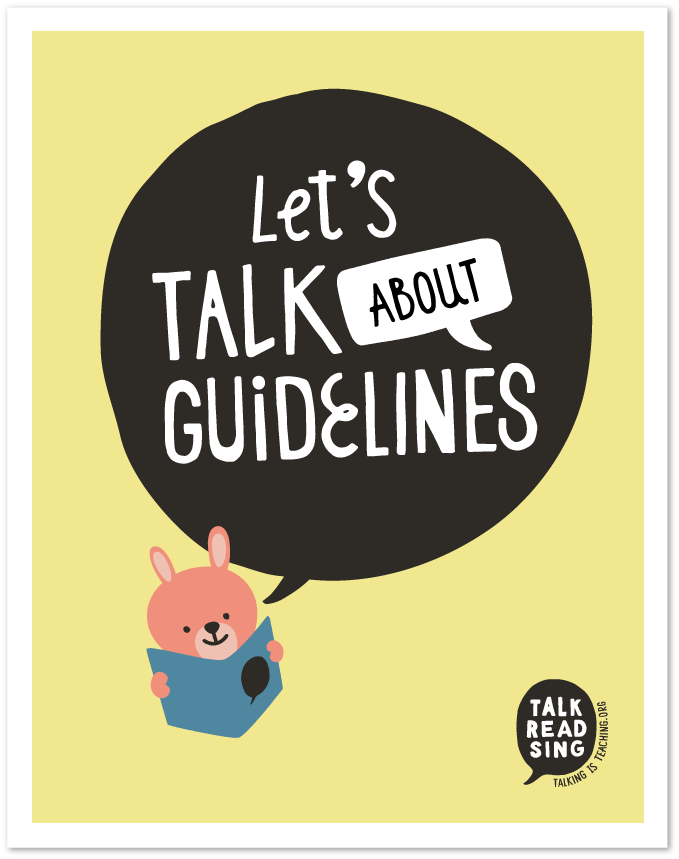
If you create a new Talking is Teaching resource, please submit it for approval via our Multimedia Submissions Form, below. This is required if you create a new resource that includes the Talking is Teaching logo.
Colors
We have carefully chosen multiple color palettes that compliment the friendly, playful nature of Talking is Teaching. On this page you’ll find each color on display with its name or code in each of the four most common color identification systems: Pantone Matching System (PMS) for professional printer inks, Hexadecimal color coding (Hex) for web design, Red Green Blue (RGB) color codes for videos and screens, and Cyan Magenta Yellow Key (CMYK) for most consumer printers. If you’re not familiar with color codes or how to use them, check out our Using Color Codes tips below.
As a general recommendation, each product – such as a poster or tip sheet – should use one palette. But feel free to use multiple palettes across multiple products as part of a collection or set.
Pantone Black, shown at the bottom of this page, is intended for use with all palettes.

R: 255
G: 209
B: 110
C: 0%
M: 18%
Y: 66%
K: 0%

R: 240
G: 144
B: 124
C: 2%
M: 53%
Y: 47%
K: 0%

R: 195
G: 59
B: 50
C: 17%
M: 91%
Y: 90%
K: 6%

R: 162
G: 209
B: 131
C: 39%
M: 0%
Y: 64%
K: 0%

R: 148
G: 184
B: 187
C: 43%
M: 16%
Y: 24%
K: 0%

R: 22
G: 160
B: 219
C: 74%
M: 21%
Y: 0%
K: 0%

R: 183
G: 206
B: 207
C: 28%
M: 10%
Y: 16%
K: 0%

R: 126
G: 167
B: 173
C: 53%
M: 23%
Y: 29%
K: 0%

R: 132
G: 199
B: 188
C: 48%
M: 3%
Y: 30%
K: 0%

R: 22
G: 160
B: 219
C: 74%
M: 21%
Y: 0%
K: 0%

R: 9
G: 117
B: 167
C: 88%
M: 48%
Y: 15%
K: 1%

R: 240
G: 231
B: 142
C: 7%
M: 3%
Y: 55%
K: 0%

R: 239
G: 193
B: 178
C: 5%
M: 27%
Y: 25%
K: 0%

R: 240
G: 144
B: 124
C: 2%
M: 53%
Y: 47%
K: 0%

R: 190
G: 187
B: 186
C: 26%
M: 22%
Y: 22%
K: 0%

R: 79
G: 135
B: 160
C: 72%
M: 37%
Y: 27%
K: 2%

R: 255
G: 209
B: 110
C: 0%
M: 18%
Y: 66%
K: 0%

R: 246
G: 179
B: 51
C: 2%
M: 32%
Y: 92%
K: 0%

R: 148
G: 50
B: 53
C: 28%
M: 90%
Y: 77%
K: 25%

R: 145
G: 202
B: 100
C: 47%
M: 0%
Y: 80%
K: 0%

R: 157
G: 190
B: 170
C: 40%
M: 13%
Y: 36%
K: 0%

R: 125
G: 156
B: 144
C: 54%
M: 27%
Y: 44%
K: 2%

R: 227
G: 225
B: 123
C: 13%
M: 3%
Y: 65%
K: 0%

R: 240
G: 144
B: 124
C: 2%
M: 53%
Y: 47%
K: 0%

R: 149
G: 152
B: 143
C: 44%
M: 34%
Y: 42%
K: 2%

R: 189
G: 210
B: 220
C: 25%
M: 9%
Y: 9%
K: 0%

R: 9
G: 117
B: 167
C: 88%
M: 48%
Y: 15%
K: 1%

R: 215
G: 64
B: 34
C: 10%
M: 89%
Y: 100%
K: 2%

R: 227
G: 184
B: 126
C: 11%
M: 28%
Y: 57%
K: 0%

R: 245
G: 207
B: 178
C: 3%
M: 20%
Y: 29%
K: 0%

R: 98
G: 38
B: 80
C: 58%
M: 93%
Y: 40%
K: 32%

R: 230
G: 60
B: 47
C: 4%
M: 91%
Y: 91%
K: 0%

R: 246
G: 198
B: 92
C: 3%
M: 22%
Y: 75%
K: 0%

R: 115
G: 200
B: 175
C: 54%
M: 0%
Y: 39%
K: 0%

R: 211
G: 203
B: 189
C: 17%
M: 16%
Y: 24%
K: 0%

R: 100
G: 177
B: 188
C: 60%
M: 13%
Y: 25%
K: 0%

R: 226
G: 89
B: 40
C: 7%
M: 79%
Y: 79%
K: 1%

R: 183
G: 129
B: 79
C: 26%
M: 50%
Y: 77%
K: 6%

R: 255
G: 201
B: 153
C: 0%
M: 24%
Y: 41%
K: 0%

R: 46
G:42
B: 38
C: 66%
M: 64%
Y: 67%
K: 67%
Tips and Guides
We’ve created a quick reference on what color codes are and how to use them in common applications.
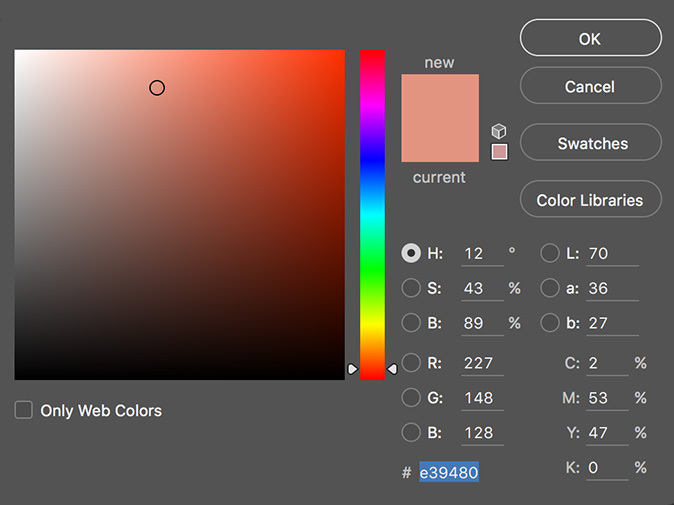
Language is at the heart of Talking is Teaching and we have taken great care in thinking through creative ways to present the campaign’s text. In fact, a unique new font has been specially designed by hand just for Talking is Teaching. Using it consistently is extremely important to communicating the “Talk, Read, Sing” message.
TRS Hand is our primary font, used across all our products. It is most commonly used for speech bubbles and headlines, but not for long paragraphs.
In most applications, TRS Hand should be black. If it’s used inside a speech bubble it should be white. Colors are OK when used as a headline or when color is used to convey meaning. But when selecting colors, less definitely equals more: work to keep it simple and try to avoid using more colors than are absolutely necessary.
When using this font on posters and printed materials, we recommend using all capital letters. For web-based content, please use standard characters.
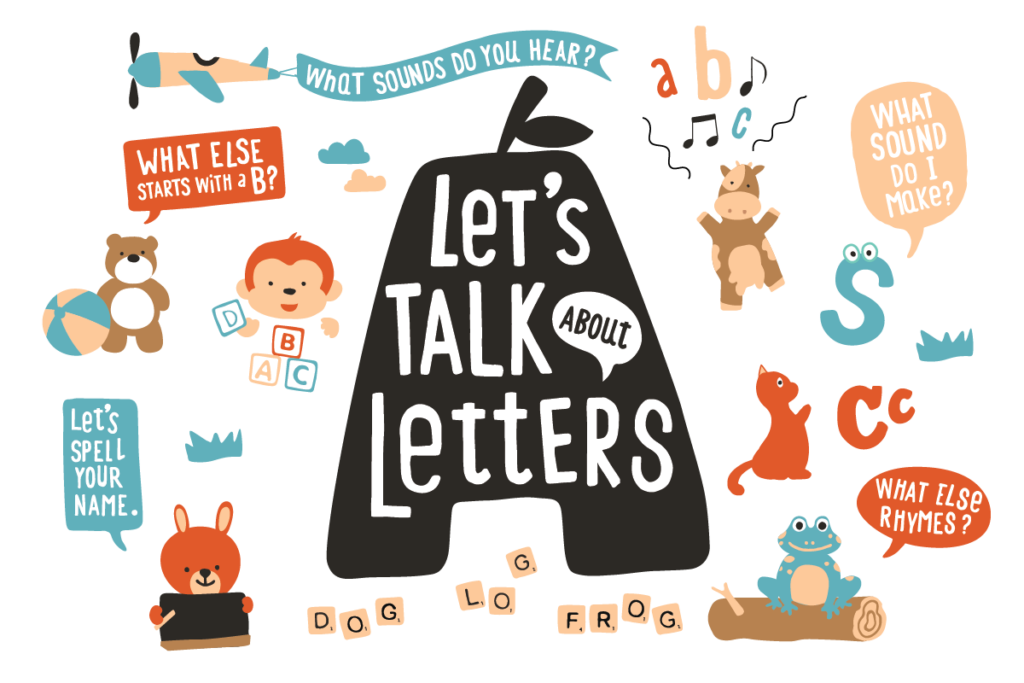
Din is our secondary font for paragraphs and longer blocks of text that accompany Talking is Teaching artwork, but are not in the artwork itself.
If your software allows, we recommend setting the “leading” or the space between lines to +4 when using Din. So for 12pt text, set the leading to 16pt. It should almost always be black.
Din is not the property of Talking is Teaching, so we can’t give it away, but you can purchase your own copy from any number of online retailers.
If you don’t have access to Din, Helvetica or Arial may be used in its place.
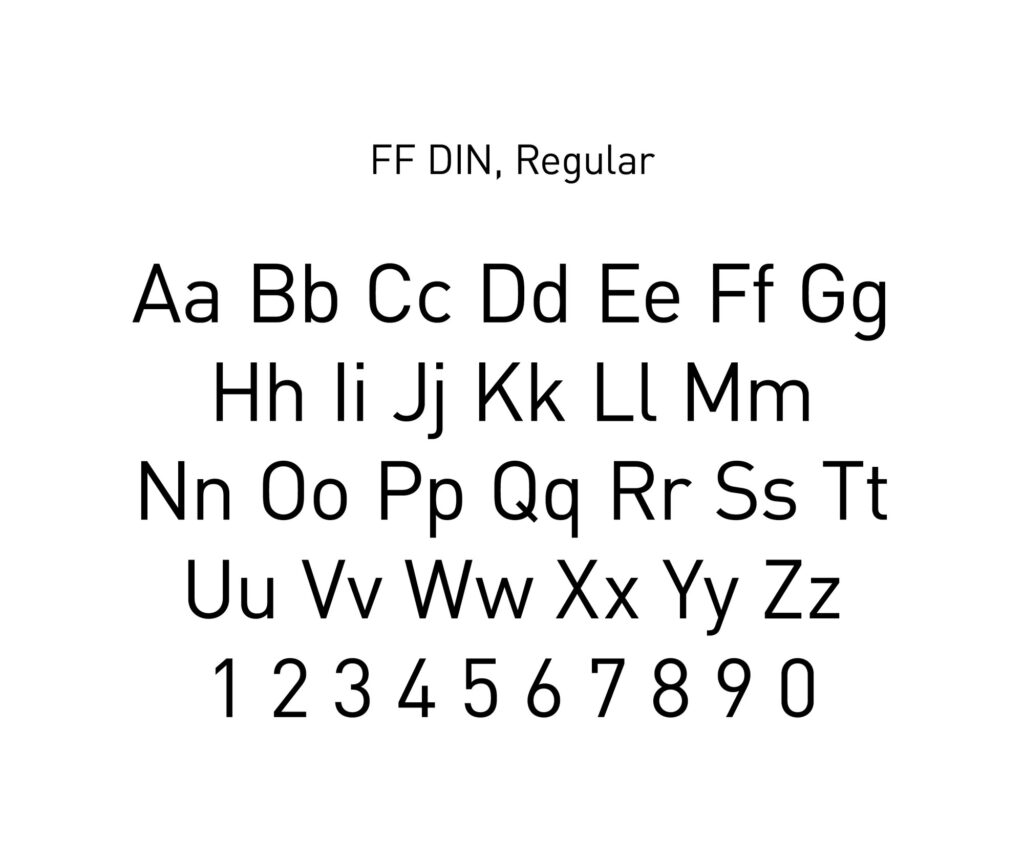
Tips and Guides
We’ve compiled a few tips on capturing the Talking is Teaching campaign voice and maximizing the effectiveness of prompts.
We have created a library of illustrations that can be used to create posters, social graphics, and more.
All illustrations are in both PNG and EPS formats. PNGs are quick and easy to use for most applications, like PowerPoints and Word documents. EPS files are useful when working with design professionals and print shops or when creating very large products as they can scale to any size without becoming pixelated.
If you would like to create new illustrations, please first read our Graphic Style Guide and refer to our General Design Principles guide. Once you create the illustration and before it is utilized in materials, please submit it to the Multimedia Submissions Form for approval.
Filtering by:
Community Partner Resource Types
Tips and Guides
If you are interested in creating new illustrations, please first read our guide on general design principles, as well as our Graphic Style Guide.
The logo is the centerpiece of the Talking is Teaching visual identity and it should be included on all Talking Is Teaching products of any size or medium. To make that easier, we’ve published a few different versions here – which can be used in different situations – and created PNG and EPS versions of each. PNGs are quick and easy to use for most applications, like PowerPoint and Word documents. EPS files are useful when working with design professionals and print shops or when creating very large products as they can scale to any size without becoming pixelated.
The most important thing to remember when using the logo is consistency. Please use only the versions listed here, and pay close attention to the guidelines on this page. To make sure the logo always looks exactly the same, never stretch, squish, recolor, or otherwise alter the logo. That way, anyone who sees it will be able to instantly recognize it and associate it with the campaign.
By downloading this content, you acknowledge that the Bill, Hillary & Chelsea Clinton Foundation (the “Foundation”) owns all intellectual property rights to the Foundation’s name and logos, including the names and logos of the Foundation’s programs and initiatives. The Foundation grants to you a limited, worldwide, non-exclusive, non-transferable, non-commercial, royalty-free license to use the Too Small to Fail (“TSTF”) content subject to the TSTF style guide (which can be found here) and our licensing terms (which can be found here).
This is the primary logo and should be used on most products. Please include the full logo, and never remove the URL when using this version.
The logo looks best on white or very pale or light backgrounds. It should not be stretched or rotated.
If necessary, the logo colors may be reversed (white talk bubble and black text) to be placed on a dark solid background, but please avoid this use if possible.
By downloading the logo, you agree to the Logo Usage Agreement above.
This secondary version of our logo is great for posters, billboards, and other products with extra space to spread out. It doesn’t include the URL though, so if you use this version, please be sure to include the standalone URL (below) somewhere else on the product.
By downloading the logo, you agree to the Logo Usage Agreement above.
This standalone version of the URL should be used along with the landscape version of the logo. It should be sized to match the landscape logo. To accomplish that, make the height of the URL the same height as the word “Talking” in the logo.
If you’re able, it’s great to recolor the word “IS” in the URL to match one of the primary colors in your products (preferably from one of our color palettes). This will help the logo stand out and be noticed.
By downloading the logo, you agree to the Logo Usage Agreement above.
If you choose to create video content – such as a PSA or an ad – we encourage you to utilize one of the following end frame animations.
Please submit any PSAs you make to our Multimedia Submissions Form for approval.
By downloading these animations, you agree to the Logo Usage Agreement above.
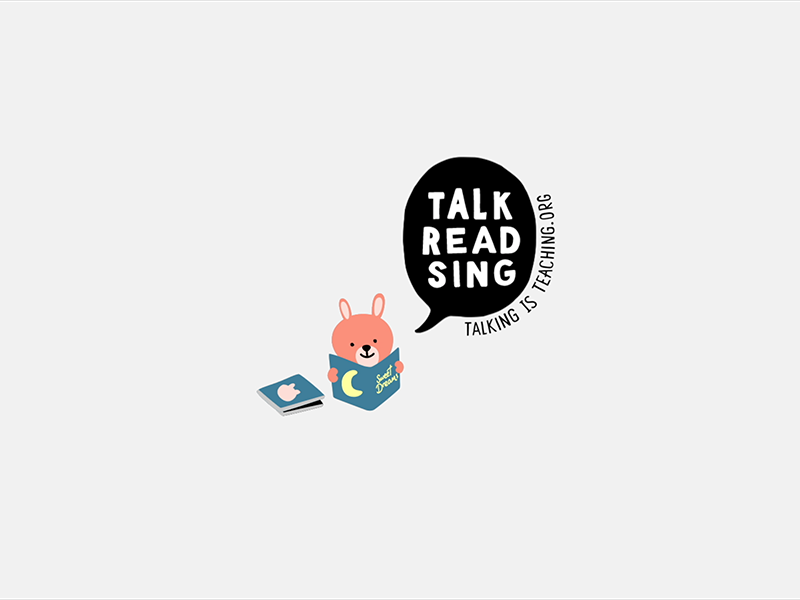
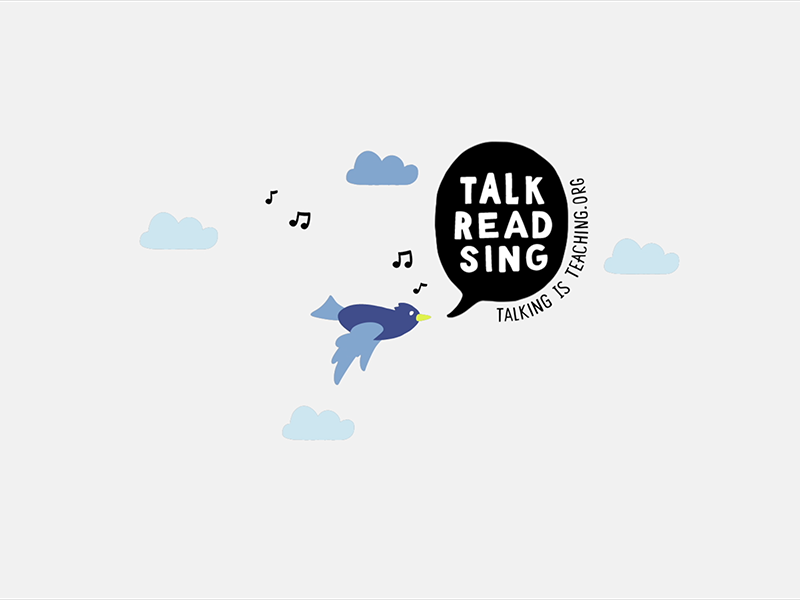

We’ve put together various guides to help you in utilizing our logo in your customized resources. Please be sure to read the guides before downloading and using any of our logos.

A few basic tips on treating our bubble well.
No matter which version of the logo you’re using or where you’re using it, it’s important to give it some room to breathe.
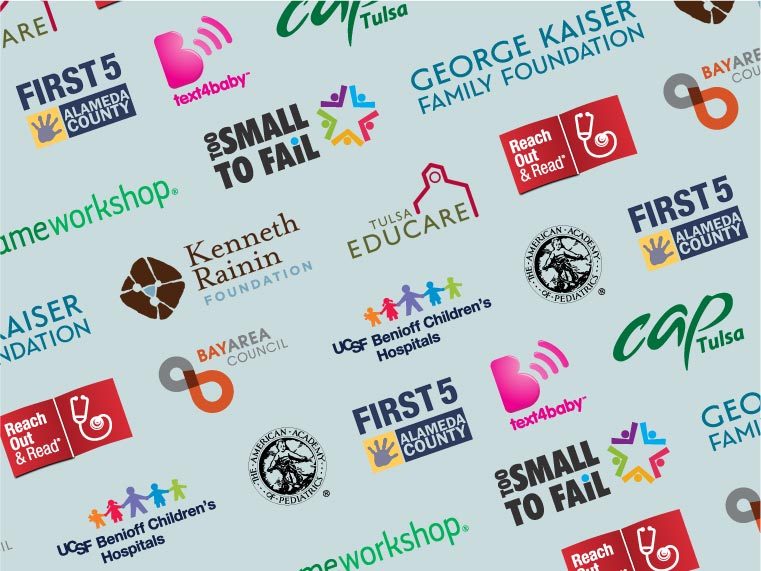
Tips for adding your organization’s logo as well as your partners’ logos to Talking Is Teaching Products.
We have compiled tips and guides to help you create and customize Talking is Teaching materials. For additional information, please read our Talking is Teaching Graphic Style Guide.
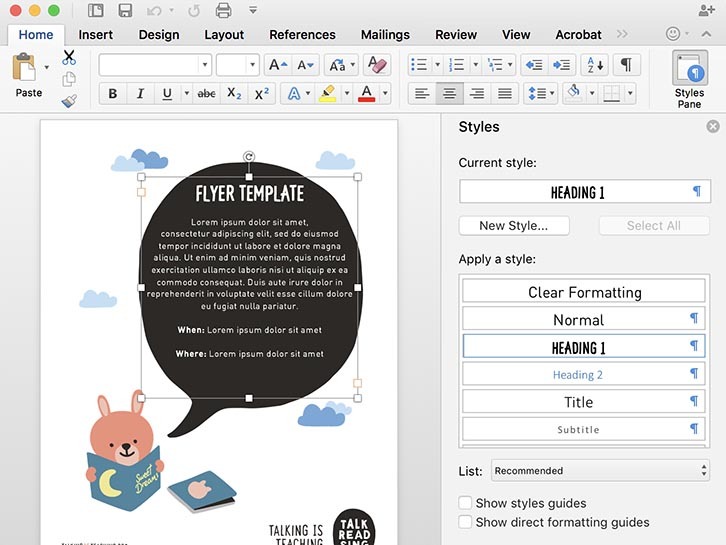
When to feel empowered to create and when to request approval.
The core ideas behind our unique illustration style.

Tips for adding your organization’s logo as well as your partners’ logos to Talking is Teaching products.

A quick reference on what color codes are and how to use them in common applications.
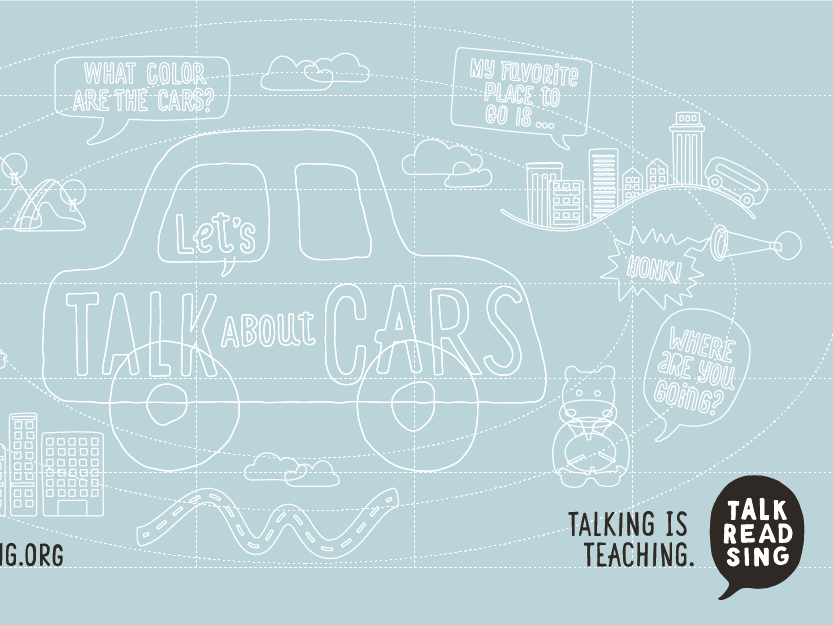
Tips for creating new posters with existing characters.
Tips on capturing the campaign voice and maximizing the effectiveness of prompts.

A few basic tips on utilizing our logos.
No matter which version of the logo you’re using or where you’re using it, it’s important to give it some room to breathe.
Most Talking is Teaching products are laid out by design professionals using industry standard software. We’ve made many of those products available on this site as ready-to-print files. We recognize, however, that you may have needs above and beyond our resources, and that not everyone has access to designers or design software. To that end, we’ve prepared templates in commonly available formats that almost anyone can open and use to create beautiful Talking is Teaching products.
If you utilize the templates to create new Talking is Teaching materials, please submit it for review through our Multimedia Submissions Form.
This Microsoft Word template is great for tip sheets, handouts, agendas, and all kinds of similar documents.

Use this Microsoft Word template to make flyers for events and to share information about your campaign.

Need to present your work on the campaign? Use our simple Microsoft PowerPoint presentation template.
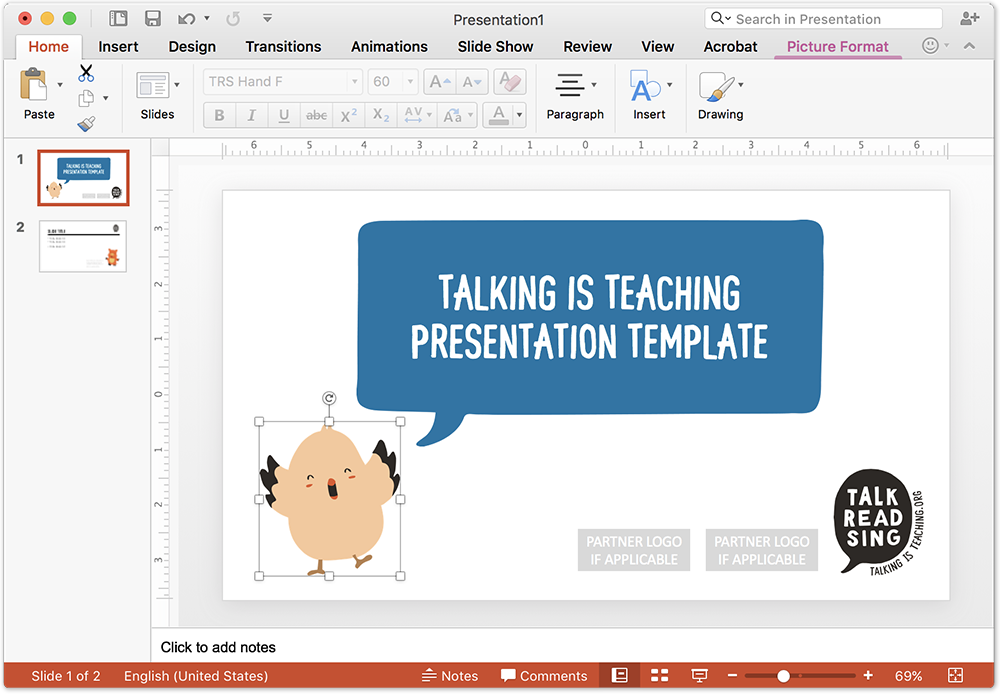
Social Graphic Template
We know that not everyone has access to advanced design tools. So, to make our creative easier to work with on social, we’ve prepared a PowerPoint template. Just visit the Illustrations tab, download the illustration and speech bubble you like best, and paste them in.
A number of great image editors exist online, too, like Aviary and Canva. We don’t have templates for those, so just emulate the one character + one bubble + logo layout if you use them.